[honeysuckle planting technology] how to grow honeysuckle
Strengthening the field management of honeysuckle is the main link of high yield. Field cultivation management generally includes rational arrangement of population structure, ploughing and weeding, fertilization and watering, shaping and pruning and pest control and so on. Honeysuckle as a commonly used traditional Chinese medicine, to some extent, the quality of medicine is more important than the output of medicine. So what is the planting technology of honeysuckle?
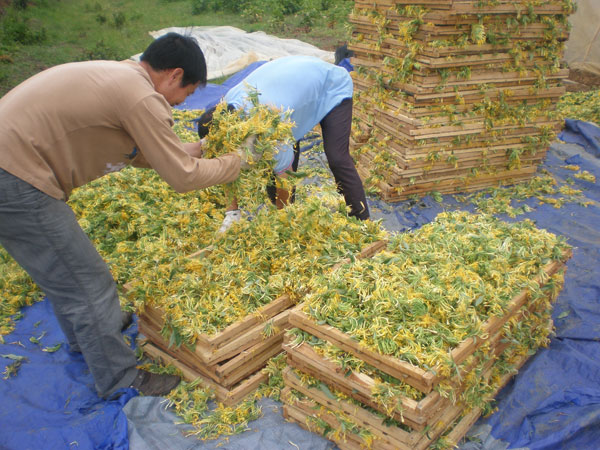
Planting technique of Flos Lonicerae
First, ploughing and weeding
There are generally 3 murmurs for weeding and weeding 4 times a year. The first time sprouting new leaves in spring, the second time in June, the third time in July-August, and the fourth time in late autumn and early winter. When ploughing, it should be shallow around the plant rhizosphere and a little deeper in the distance to avoid root injury. After the fourth intertillage and weeding, the soil should be cultivated in the rhizosphere of the plant to survive the winter.
Second, topdressing
Topdressing should be carried out every year after sprouting in early spring and after each flower bud harvest. In spring, summer and autumn, mature human and animal manure water or ammonium sulfate, urea and other nitrogen fertilizers were applied in shallow ditches beside the roots, and then covered with soil. In winter, each plant was fertilized with farm manure 5murl 1kg, ammonium sulfate 100g, and calcium superphosphate 200g, which was applied in an annular shallow trench beside the root. After application, fertilizer was applied and soil was cultivated. If there is no Rain Water to water after fertilization.
Third, shaping and pruning
1.1 the purpose of plant pruning for 2 years is to cultivate an upright and sturdy trunk. When the height of the trunk is 30m / m, the top tip is cut off to promote the lateral bud to germinate into branches.
2.3 years later, after the Spring Festival sprouting, five stout branches were selected as the main branches in the upper part of the trunk, which were planted in two layers.
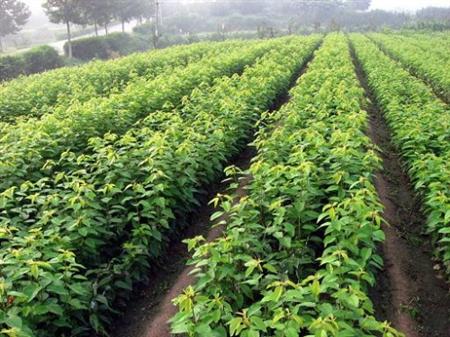
In the primary branch growing from the main branch, 5 Murray 6 pairs of buds were retained, the upper part was cut off, and in the secondary branch growing from the primary branch, 6 Murray 7 pairs of buds were retained, and the upper part was cut off, and then the hook-shaped shoots were removed from the third-order branch growing from the secondary branch. In general, the young branches with dense and short nodes and thin leaves germinated in the secondary branches or on the original old flower branches after spring are flower branches and should be retained. Frosts Descent needs to be cut in winter from the back to the end of the freeze. Cut off the withered old branches, disease and insect branches, thin and weak branches and long branches that disturb the tree shape when cutting in winter. After each flower bud harvest, summer pruning should also be carried out, and summer pruning should be enough. After each pruning, you have to top up once.
Fourth, drainage and irrigation water
In the flowering period, or in case of dry weather and too much Rain Water, it will cause falling flowers, retting flowers and other phenomena, so it is necessary to do a good job of irrigation or drainage in time.
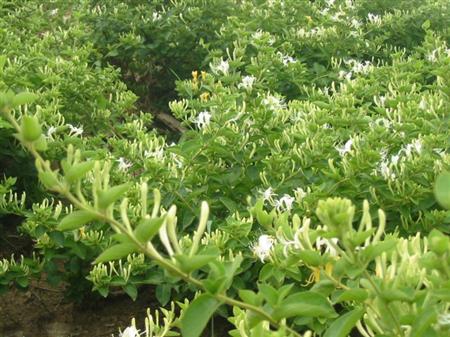
Diseases and insect pests and their control
1. The disease is mainly powdery mildew, which harms leaves and tender stems. At the initial stage of the disease, round white velvety mildew spots appeared, then expanded and connected into pieces, forming white powder spots of different sizes, which finally caused falling flowers, withered leaves and withered branches. Prevention and control methods are mainly the following two aspects: first, reasonable close planting, shaping and pruning, improving ventilation and light transmission conditions, can enhance disease resistance. Second: spray 25% trimethoprim 1500 times or 50% topiramate 1000 times, once every 7 days, even spray 3 Murray 4 times.
two。 Omethoate can be used to control aphids and phoxim to control coffee tiger longicorn beetles.
The efficacy and effect of Honeysuckle in Water
Honeysuckle, also known as honeysuckle, honeysuckle, double flower, etc., is sweet and cold in nature and fragrant in qi. It has the effect of spreading wind-heat, clearing heat and detoxification. It is suitable for all kinds of febrile ☆ to prohibit ☆ disease, such as body heat, heat-toxic sore carbuncle, sore throat and so on. Modern pharmacological studies have shown that the effective components of Flos Lonicerae have antibacterial, antiviral and enhance immune function. In daily life, many people often drink honeysuckle in order to protect their health. What are the effects and effects of honeysuckle soaking water?
Remove fire and prevent bad breath
To prevent halitosis, you can drink with chrysanthemum or honeysuckle. Chrysanthemum is weak in wind thinning and good in heat-clearing power. it is often used for exogenous wind and heat with mulberry leaves, and can also be used with Scutellaria baicalensis and Shanzhi to treat exuberant irritability. Chrysanthemum treatment of eye swelling and pain, whether caused by liver fire or wind-heat, can be used, because this product can not only clear liver fire, but also disperse wind-heat, often used with cicada clothes, Tribulus terrestris and so on. If the liver and yin is insufficient and the eyes are dizzy, then more places of health and Qi Zi will be used together. Chrysanthemum is very good at clearing away heat and detoxification. it is an important medicine for surgery. it is mainly used for hot sores, redness, swelling, heat and pain, especially for ulcers, swelling, pain and poison, which can be taken internally and smashed externally. In clinic, it is often used in conjunction with heat-clearing and detoxifying products such as Dingcao, dandelion and so on. Chrysanthemum can calm down liver-yang and treat head vertigo caused by hyperactivity of liver-yang. It is often used in compatibility with mother-of-pearl and kudzu.
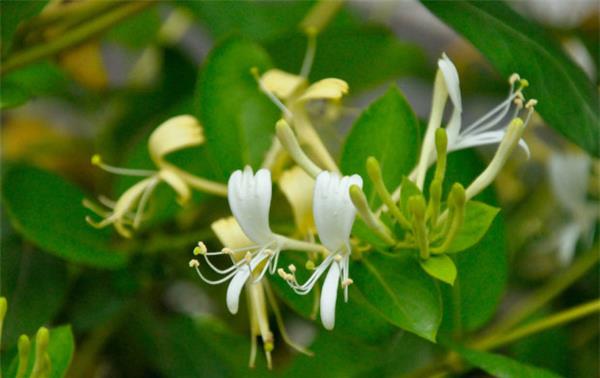
Honeysuckle cold, sweet, Qi flat, with the effect of heat-clearing and detoxification, can treat heat-toxic swelling, carbuncle and other diseases. Because it has the function of spreading and spreading, it can also treat exogenous wind-fever and febrile disease. For example, Yinqiao jiedu tablets (pills) for the treatment of wind-fever cold are based on honeysuckle. Yinhuang tablets made with Scutellaria baicalensis Georgi can treat acute upper respiratory tract infection, acute pharyngitis, acute tonsillitis and so on. Honeysuckle plus water distillation can obtain "honeysuckle dew", which has the effect of clearing heat and antipyretic, and can treat children's hot furuncle, prickly heat, summer heat and other diseases.
Therefore, for long-term angry, dry and bitter friends might as well drink some chrysanthemum and honeysuckle tea, I believe it will be of great help to you.
Sore throat and prevention of upper respiratory tract infection
Use honeysuckle to make water instead of tea to treat sore throat and prevent upper respiratory tract infection. The method is to take 20 grams of honeysuckle, fry water instead of tea or make tea, 1 dose a day.
Reproduction of Flos Lonicerae
First, seed reproduction, first soak the seeds with a new high-fat membrane in warm water, sow seeds when the crack reaches about 30%, and transplant after emergence.
Second, cuttage propagation, in summer and autumn cloudy and rainy weather, select strong 1-2-year-old branches without diseases and insect pests 30-35cm, pick the lower leaves as cuttings, cut with. After the branches were transplanted, the new high-fat film was sprayed.
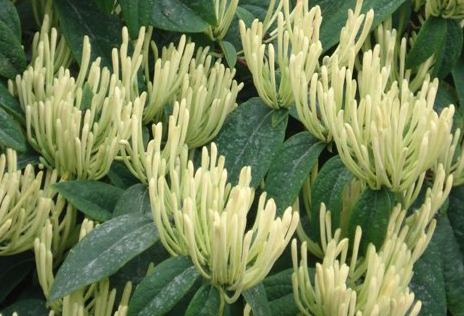
Harvest and processing of Flos Lonicerae
Honeysuckle usually blossoms in the third year after transplanting. The first and second stubble flowers are picked in mid-late May, and the third and fourth stubble flowers are picked one after another after an interval of one month. The harvest period must be before the bud blooms; when the bud changes from green to white, the upper part expands, and the lower part is cyan.
Honeysuckle is "two white flowers"; when the buds turn white completely, the flowers harvested are called "big white needles". The buds picked should be dried or dried in time, do not pile up and become moldy, and the general yield per mu is about 150 kg.
Honeysuckle cold, sweet, Qi flat, with the effect of heat-clearing and detoxification, can treat heat-toxic swelling, carbuncle and other diseases. Because it has the function of spreading and spreading, it can also treat exogenous wind-fever and febrile disease. For example, Yinqiao jiedu tablets (pills) for the treatment of wind-fever cold are based on honeysuckle. Yinhuang tablets made with Scutellaria baicalensis Georgi can treat acute upper respiratory tract infection, acute pharyngitis, acute tonsillitis and so on. Honeysuckle plus water distillation can obtain "honeysuckle dew", which has the effect of clearing heat and antipyretic, and can treat children's hot furuncle, prickly heat, summer heat and other diseases.
Therefore, for long-term angry, dry and bitter friends might as well drink some chrysanthemum and honeysuckle tea, I believe it will be of great help to you.
Sore throat and prevention of upper respiratory tract infection
Use honeysuckle to make water instead of tea to treat sore throat and prevent upper respiratory tract infection. The method is to take 20 grams of honeysuckle, fry water instead of tea or make tea, 1 dose a day.
Reproduction of Flos Lonicerae
First, seed reproduction, first soak the seeds with a new high-fat membrane in warm water, sow seeds when the crack reaches about 30%, and transplant after emergence.
Second, cuttage propagation, in summer and autumn cloudy and rainy weather, select strong 1-2-year-old branches without diseases and insect pests 30-35cm, pick the lower leaves as cuttings, cut with. After the branches were transplanted, the new high-fat film was sprayed.

Harvest and processing of Flos Lonicerae
Honeysuckle usually blossoms in the third year after transplanting. The first and second stubble flowers are picked in mid-late May, and the third and fourth stubble flowers are picked one after another after an interval of one month. The harvest period must be before the bud blooms; when the bud changes from green to white, the upper part expands, and the lower part is cyan.
Honeysuckle is "two white flowers"; when the buds turn white completely, the flowers harvested are called "big white needles". The buds picked should be dried or dried in time, do not pile up and become moldy, and the general yield per mu is about 150 kg.
Related
- Wuhan Hospital Iron Tree Blooming Result Was Instantly Frightened by the Gardener Master
- Which variety of camellia is the most fragrant and best? Which one do you like best?
- What is the small blue coat, the breeding methods and matters needing attention of the succulent plant
- Dormancy time and maintenance management of succulent plants during dormancy
- Minas succulent how to raise, Minas succulent plant pictures
- What are the varieties of winter succulent plants
- How to raise succulent plants in twelve rolls? let's take a look at some experience of breeding twelve rolls.
- Attention should be paid to water control for succulent plants during dormant period (winter and summer)
- Watering experience of twelve rolls of succulent plants
- Techniques for fertilizing succulent plants. An article will let you know how to fertilize succulent plants.



